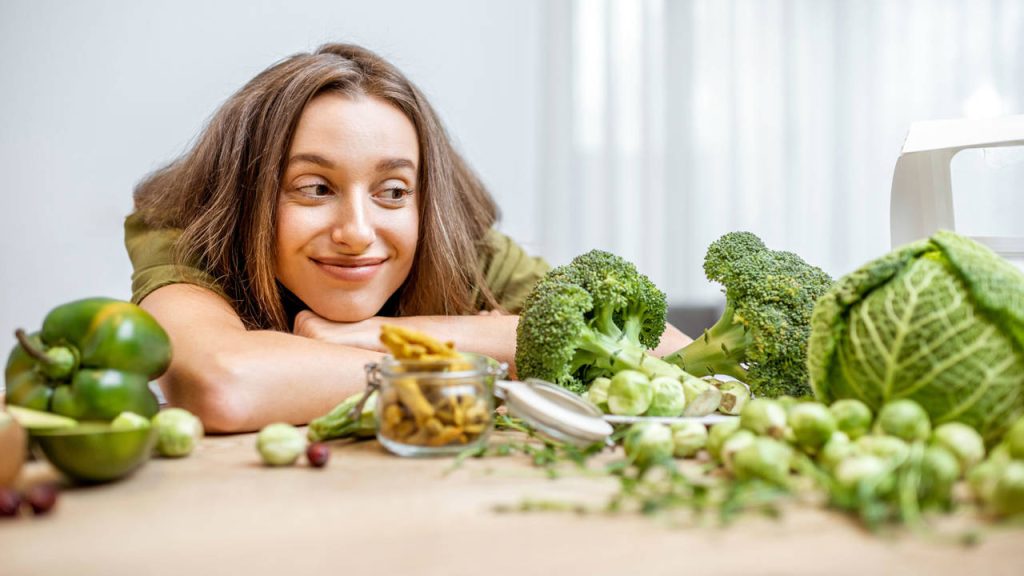Some combinations, tricks and ways of preparation help to make certain vegetables more digestive and make the most of their nutrients. Do not miss in your dishes!

Vegetables possess unique properties. They are very rich in fiber, vitamins, minerals, polyphenols, carotenes and other phytochemicals that protect us from inflammatory and cardiovascular diseases, diabetes, chronic fatigue or cancer.
Eating them raw or cooked with respect and well-seasoned is key to take advantage of their properties to the greatest extent possible. There are ways to make vegetables more digestive – something interesting for people who have some difficulty in this regard – and to maximize the assimilation of the nutrients they contain.
EATING RAW VEGETABLES AND VEGETABLES HAS MANY ADVANTAGES
Raw foods should be on the daily menu, because they contain enzymes, vitamins and other compounds that contribute to good health and are reduced or lost in cooking. For example:
- Vitamins can dissolve in water or fat during cooking. Some, such as vitamins C, B1, B6, folic acid and vitamin E are destroyed by high temperatures.
- Minerals are diluted in cooking water, especially potassium, magnesium and calcium.
- Antioxidants that give vegetables color or compounds such as glucosinolates in cabbages are reduced by increasing temperature and cooking time.
But, in addition, there are two important elements in raw fruits and vegetables that also have to do with digestion:
- They contain more enzymes that facilitate digestion, as they begin to be destroyed after 40 ºC.
- Raw foods, although we clean them well, provide small amounts of probiotic bacteria that contribute to the diversity of the microbiota and train immunity.
To benefit from the properties of raw foods, in addition to two or three pieces of fruit daily, it is advisable to consume between two and four servings of raw vegetables (in total, between 150 and 350 g), if there is no medical contraindication.
You don’t have to limit yourself to tomatoes and lettuce to reach these figures. Some vegetables that we usually consume cooked can be eaten raw.
For example, sprouted broccoli seeds or fermented cabbage (sauerkraut) can be consumed. Germination or fermentation not only increases digestibility, but also increases the density of some nutrients and enzymes.
It is important to note that taking a small number of raw vegetables at the beginning of meals helps us regulate glucose levels thanks to its fiber content.
VEGETABLES NEED YOU TO CHEW THEM WELL
Chewing food very well is key, especially raw ones, since saliva enzymes predigest carbohydrates from vegetables.
In addition, chewing heats the food, which facilitates digestion.
CONDIMENTS TO DIGEST VEGETABLES BETTER
A vegetable can be washed and eaten as is, but gentle cooking or certain preparations can also promote good digestion in many cases.
It is as important to make a good selection of foods as then digest them well to absorb their nutrients. This is where our digestive capacity comes in, which can be helped with spices and dressings.
If in addition to chewing the vegetables well, we have seasoned them with condiments that activate the substances that will decompose them within our body, much better:
- Cinnamon is added to vinaigrettes to flavor and, in addition, stimulate the secretion of gastric juices and reduce flatulence.
- Ginger with vinegar is used for marinating and stimulates saliva, bile, pancreatic enzymes and bowel movement.
- Unpasteurized miso paste provides enzymes and lactobacilli. It can be added to cold or warm sauces, which can be used to macerate vegetables.
- Lemonand apple cider and umeboshi vinegars can be added to vinaigrettes to stimulate digestive juices.
PREPARATIONS THAT FACILITATE THE ASSIMILATION OF NUTRIENTS FROM VEGETABLES
The nutrients in raw foods can be used to the maximum thanks to simple preparations:
- Germination: Sprouts, which we can prepare at home, are very dense in vitamins, minerals and digestive enzymes. You can try the sprouts of broccoli, radish, onion, mustard or watercress seeds.
- Maceration: Onion or leeks, for example, can be macerated in warm water with a splash of vinegar and a pinch of salt. Leave 20 minutes and drain before consuming. This maceration removes irritating compounds and improves the absorption of nutrients.
- Crushing: By chopping very finely or crushing the onion or garlic, enzymatic reactions are allowed that produce antioxidant compounds and beneficial to the liver such as allicin. Wait 10 minutes before consuming them raw or cooked.
- Kneading: Improving the digestibility of a vegetable sometimes involves something as simple as kneading it with your hands. In doing so, with a little olive oil, salt and spices, the fibers are broken down and enzymes are released. You can do it for five minutes with kale leaves or collard greens. In this way, the assimilation of calcium increases and they are more digestive.
- Fermentation: Practically all vegetables can be fermented, but traditionally the technique has been applied especially with cabbages. To make it at home, cut the leaves into very thin strips, knead them with a little salt so that they release liquid and put the cabbage and liquid in a pot. The cabbage should be covered, so you can add a little salted water. Then it is covered and waited about 15 days. The bacteria that develop are very beneficial.
- Pickling: A quick pickle can be made with a 50% mixture of water and vinegar. Just fill a pot halfway with florets of broccoli or other vegetables cut into thin slices or strips and cover them with the liquid. It is then covered and consumed within hours or a few days. Your fiber will have softened and become more digestible.
HOW TO COOK VEGETABLES TO DIGEST THEM BETTER
Raw vegetables are very healthy, but it is also true that the absorption of some nutrients and antioxidant compounds improves with cooking. In addition, cooked, some vegetables are easier to digest, especially for older people, whose ability to produce digestive acids and enzymes has declined over the years. Vegetable Fibre can also be difficult to break down if the microbiota does not have enough diversity and quantity of digestive bacteria, factors that are also affected over the years.
Some foods improve nutritionally if cooked, as cooking will help you better absorb your vitamins and minerals:
- Tomato lycopene, for example, is better absorbed if cooked with olive oil.
- Apple pectin feeds our microbiota better if we roast it.
- The beta-carotenes in carrots are best absorbed if cooked and taken with olive oil.
- Calcium from spinach or asparagus is more available if they are sautéed.
In any case, cooking should be gentle, at low temperature or for the shortest possible time:
- Steamed: Vegetables such as cabbages can be steamed for 7-10 minutes. There is little loss of vitamins, increases the availability of calcium and is more digestible.
- In papillote: Artichokes or sweet potatoes can be wrapped in baking paper with oil, salt and spices to roast them for about 20 minutes.
- Sautéed: Spinach, asparagus, turnip, carrot, etc., can be sautéed 7-10 minutes in oil or water with salt and spices.
- Boiled: To make green beans are enough 3-5 minutes.
COMBINE RAW AND COOKED VEGETABLES
There is no need to consider the dilemma of whether raw or cooked foods are healthier. It is best to combine them. Some foods are best used if consumed raw, and others, cooked.
- In general, raw foods provide vitamin C and other micronutrients and enzymes that are lost or reduced with high temperatures.
- Instead, cooking can improve the digestibility and absorption of some nutrients from other foods.
In any case, a table served with varied raw vegetables, richly seasoned or cooked denotes a sensitivity to natural foods that can only be very beneficial for health in general.
DIGESTIVE PROBLEMS THAT MAKE IT DIFFICULT TO DIGEST VEGETABLES
Another indication for cooking a vegetable is that it is not digested well. If a raw vegetable causes bloating, gas, heaviness or diarrhea, it can be for several reasons. Some of them are:
- You suffer from an allergy or intolerance to one or more foods. The vegetables that most frequently cause allergy are lettuce, carrot, celery, cabbage, eggplant, tomato and pepper.
- Excess heartburn, which can make you feel sick about tomatoes, garlic or oranges.
- Bacterial overgrowth (SIBO) or other alteration of the intestinal microbiota.
If you suspect that any of these may be your case, you can consult with a specialist integrative doctor to perform the appropriate diagnostic tests and recommend treatment.
CHOOSE VEGETABLES ACCORDING TO THE SEASONS
A good diet is the one that adapts to you, and not the other way around. As oriental medicines have always said, it is advisable to adapt the type and number of vegetables consumed at the time of year and day, and take into account the characteristics of the person.
- In spring-summer, you can consume the juicy raw vegetables that nature offers us, such as cucumbers, tomatoes and lettuce. It is ideal to have a small bowl of seasonal fruit at breakfast and, as a starter of the meal, a salad with lettuce, tomato, beetroot, carrot, radish … This will give us a good dose of enzymes, vitamins and hydration at times of day when it is hotter and there is more digestive strength. But at dinner it is better to take the vegetables a little cooked or marinated, because they will sit better.
- In autumn you can increase the proportion of cooked vegetables and reduce the raw. So, we can enjoy cabbages and other consistent vegetables.
- In winter you have to reduce the proportion of raw and cold food. We can take vegetables such as arugula, canons or endive, as they contain bitter principles that stimulate digestion. In addition, it will help us to dress them with spices, such as ginger, cinnamon and turmeric, which warm us and stimulate the production of gastric juices.








